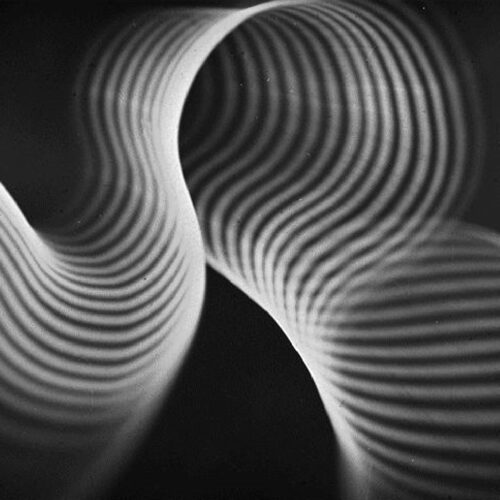

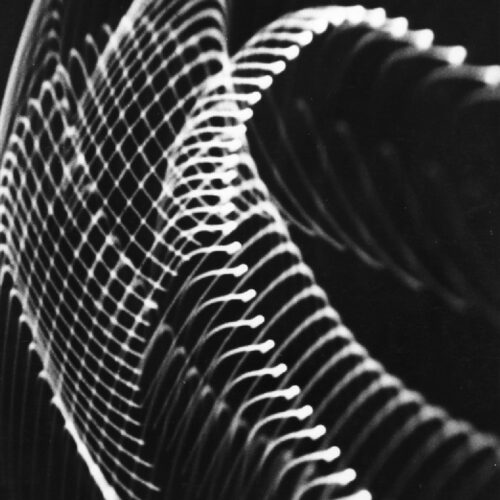

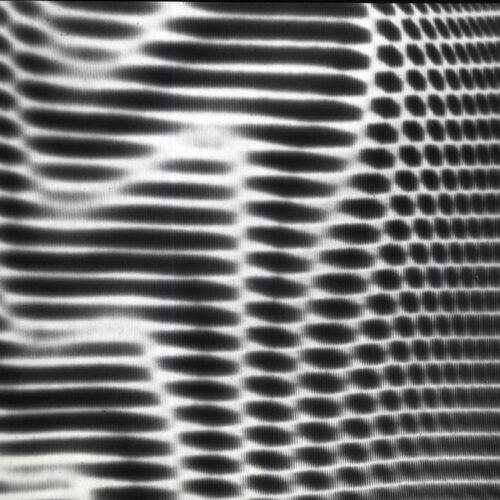





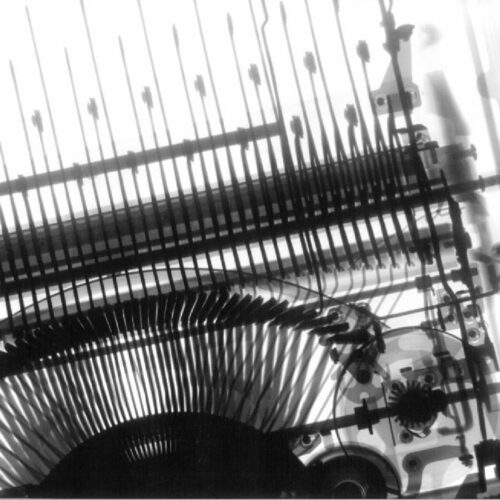

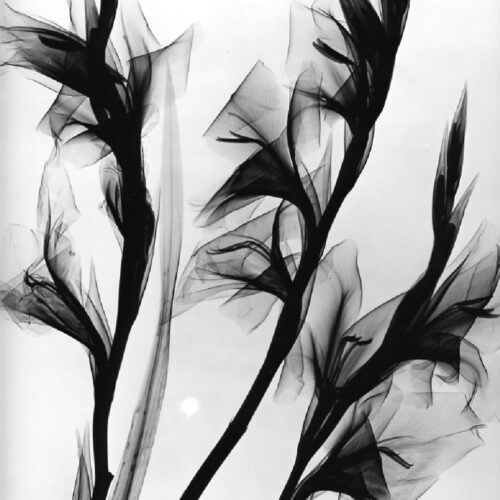



From Lightforms to Oscillograms
In the Experimental Aesthetics exhibition shown in 1959, the earliest series of artistic works by Herbert W. Franke – which were created from 1952 onwards – were shown. They are among the works now known as generative photography, a style of photographic art that developed in the 1950s and 1960s and used the camera for abstract, algorithmic design. These photographers built on aesthetic ideas that had already been developed by artists such as La szlo Moholy-Nagy in the 1920s and 1930s. However, at that time it was still without the systematic design approach that was then pursued by Franke and a small group of artists, which also included Gottfried Ja ger, Karl Martin Holzha user and Hein Gravenhorst.


In contrast to depictive photography, such works are visual inventions, which show forms and structures that were not there previously, but are created or made visible through special technical means. Franke was particularly fascinated by curves as an aesthetic style element. The physical phenomena that underlie the various photo series from this early period often include mechanical processes such as oscillations and vibrations as well as deformations under the influence of elasticity, and finally moire effects on curved surfaces. Franke also played with different techniques, for example he examined the aesthetic dimension of the images with X-ray machines and already used an analog computer with an oscillograph for artistic design.
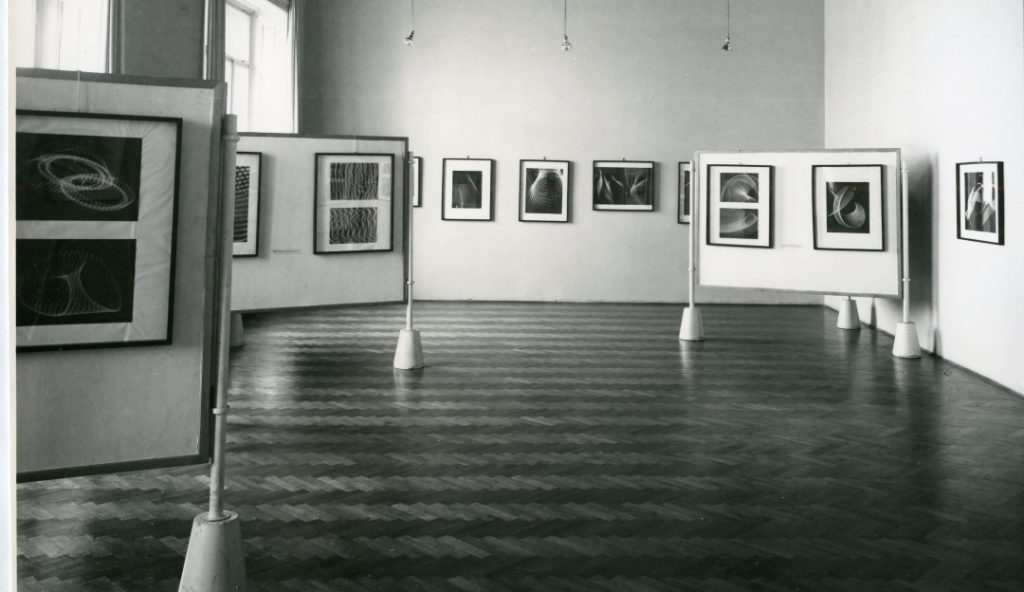

In his experiments with graphics that are constructed from superimposed curves, H. W. Franke was guided not least by his theoretical considerations. Already in his book Art and Construction, published in 1957, he put his principle up for discussion. It is based on the knowledge that works of art have a balanced relationship between order and disorder, which was later confirmed and explained in information psychology. One consequence of this relates to the construction of visual and auditory aesthetically optimal structures: If complex elements are used for this, then their number must remain small in order to create a clear structure. And vice versa: If many elements are to combine into a complex structure, then you need simple elements because otherwise the structure is perceived as chaotic.
Franke found suitable geometric elements in simple curves, especially when they have the mathematically defined property of continuity, i.e. have no interruptions, kinks or irregular changes in curvature. Such curve shapes are easy to describe mathematically, and many phenomena that occur in physics are characterized by continuous progressions. For this reason, arrangements were used or built for the “Flock of Curves” (Kurvenscharen) work group, which are characterized by the appearance of continuous curves when visualized.
Forms of Light Series


The forms of light, created with the help of the then photography apprentice Andreas Hu bner in the Siemens laboratories, show the realization of abstract pictorialideas. In contrast to depictive photography, the forms of light are the realization of Herbert W. Franke’s abstract pictorialideas – visual inventions, if you will. They are linked to the light graphics of the 1920s, but here they are about motifs that were created systematically under physically defined conditions. For the forms of light mechano-optical proprietary designs were used. The main instruments were white-painted, illuminated wires that were moved through the room with the aperture open in front of a chiaroscuro illuminated background. Some motifs were also created with a rotating disk set up in the foreground with free gaps through which the illuminated wire was recorded with the aperture open.
Series Analog Graphics | Oscillograms


The series Oscillograms was created with the help of an analogue computing system built by the Viennese physicist Franz Raimann in coordination with Herbert W. Franke, with which the basic arithmetic operations such as addition and subtraction, multiplication and division as well as differentiation and integration could be carried out. This was used to develop the graphic elements, mostly curves. The output device was a cathode ray oscillograph borrowed from an electronics hobbyist -hence the name of the Oscillogram series. A camera was ultimately used to document the images. In some cases, the camera was moved past the screen with the aperture open while the room was being recorded, which resulted in a typical fanning out of the basic figure; That’s why Franke’s moving camera images were sometimes referred to as pendulum oscillograms.
Series of Spatial Studies


The series of spatial studies was – like the forms of light – drawn into space through the movement of elastically deformed white – painted wires. Here too, the lighting was done by projecting a line grid. The deformed wire was suspended and set in motion. The striped lighting created the light-dark structures. The phase images created during the movement process added up to form a complete virtual spatial object when the aperture was open. Both rotationally symmetrical and translationally structured geometric structures were examined.
Series of Band Shapes


To prepare the bandshapes, strips of transparent film were provided with parallel black lines in longitudinal direction. They were bent and twisted and then their ends joined together to form closed ribbons. Due to the natural elasticity of the film plastic, they assumed a low-energy state, with the naturally occurring equilibrium shape being described by continuous curves. The bands were photographed against the background of a frosted glass pane illuminated from below, forming dark curves. Striking places in the configurations are those where the sets of curves intersect in the perspective view.
Series Waveforms


This series is based on a special optical phenomenon, the so-called moirés. You can see them when you look through ribbed sheer curtain fabrics, for example. The overlay of the lines creates secondary patterns and apparent movements that are similar to optical illusions. They have also been the subject of mathematical calculations, revealing the astonishing fact that the secondary patterns are enlargements of the original pattern. To examine their aesthetic effect, two transparent films printed with parallel straight lines were placed on top of each other, which initially leads to uninteresting, uniform patterns. By slightly lifting and bending the filmon top, which forms a continuously shaped spatial surface due to its elasticity, however, the complexity of the structures can be increased to achieve an optimal aesthetic effect. The photographic documentation was again carried out in front of a fluorescent screen.
Series X-ray | Ultralight


H. W.Franke received the earliest inspiration to engage in artistic experiments when he worked on electron optics as part of his dissertation. The aesthetic quality of the images from the electron microscope led himto the idea that scientific photography instruments could also be used for experiments that do not serve research, but rather the creation of aesthetically interesting images. And he also toyed with the idea of converting this type of laboratory equipment into art machines. His short-term work in industry enabled him to carry out experiments with more than just standard X-rays. In one of the two X-ray series he used “soft rays”, as they are used in medicine to irradiate the skin. With this he looked intothe inner workings of fruits and plants. In the second series he uses hard radiation, normally used in materials testing, to shine through stone and steel. His objects, on the other hand, were everyday objects such as a cigarette case, a typewriter or an egg cup. What emerged had completely different aesthetic qualities than ordinary photographs of these objects. This is particularly true for the transparency gained through radiation. The unusual view of things stimulates further thoughts: These images point out that the way we visually perceive is only one possible view of the world among many, a view that only shows partial aspects of the thing in itself, that behind it lies in secret. The images were partly created in collaboration with the X-ray expert Helmut Volland.
Aerograms Series


While working with the spray gun, Franke noticed that objects that are not lying flat on the surface, but are slightly above it, are depicted in much greater detail than one would expect. Surprisingly, even details of thesurface facing the spray jet can be seen in the image – as if a view around the object had been achieved. If you let the spray gun move over the object and spray exactly vertically from above so that the geometry of the flow does not change, then this effect becomes particularly clear. The physical effect: The beam path does not run in a straight line as usual, but follows the flow lines that hug the surface all around. This leads to the surprising insight that a current system can also have imaging effects -a fact that could perhaps be related to the orientation ability of animals living in water. Regardless of this, visually appealing images are created in this way, which point to a third way of seeing our world – in addition to optical images and X-ray transparencies.
